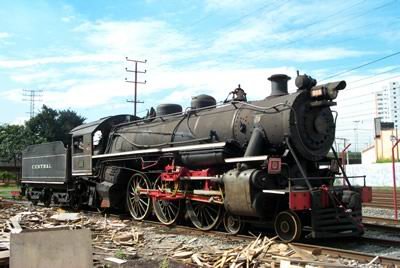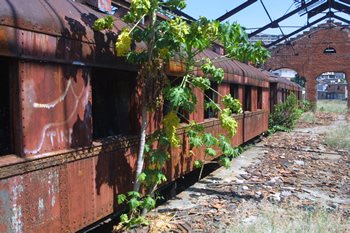|
Cruzeiro do Sul: the steel age |
 |
|
Interior of the Cruzeiro do Sul’s restaurant car, when the express train service was still in operation. |
|
In 1929 – the year when the 500 kms of the first paved road between Rio and São Paulo was inaugurated – the first express train linking the two cities also was introduced. The night train, known as Cruzeiro do Sul (Southern Cross), inaugurated the steel age on Brazilian railroads, with its carbon steel carriages. The express also was known as the Blue Train |

|
|
The Velha Senhora, restored and in condition to roll, at the São Paulo Immigrants Museum. |
|
because the cars were blue with golden trim. Some even called it the Senator’s Train because it was heavily used by politicians to make the trip between Rio de Janeiro, the federal capital at the time, and São Paulo. |
|
|
One of the locomotives used to pull the Cruzeiro do Sul was preserved by the Brazilian Railroad Preservation Association (ABPF) and now is in the Immigrants Museum in São Paulo. Known as the “Velha Senhora” (Old Lady), the Baldwin engine, a Pacific (4-6-2) built in 1927, was used on the Rio-São Paulo run until the 1950s. |
|
The 4-6-2 wheel set was a characteristic of a Pacific-type engine |
|
|
Retired from service, the engine remained parked on a shunt in Cachoeira Paulista (SP) between 1961 and 1979. It was given to the museum through an agreement between the RFFSA and ABPF and restored in 1998. To this day, it pulls a cultural train carrying passengers for the Museum. However, if one of the Cruzeiro do Sul's locomotives was salvaged, the same cannot be said about the carbon steel cars. |

|
|
The scrapped carbon steel cars, in Marítima's yard in Rio de Janeiro |
|
An entire train - manufactured by American Car and Foundry in 1929 - lies completely destroyed and abandoned in a Rede Ferroviária Federal rail yard in the port zone of Rio de Janeiro. It consists of five sleeper cars with nine cabins each and a restaurant-baggage car. The cabins were equipped with a double-decker bed, washbowl, mirror and a chair. The restaurant car contained tables and chairs, armchairs, a kitchen, food dispensary and the train chief's office, as well as a baggage compartment. However, today only rusted carcasses of the cars remain. In fact, one of the carriages burned up. In 1945, the Cruzeiro do Sul switched from steam to diesel-electric traction. In 1950, the stainless steel cars substituted the carbon steel units and the train's name was changed to Santa Cruz. |
